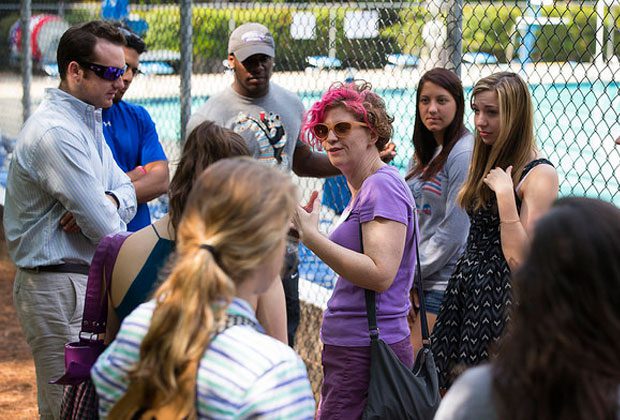Why we swim

Furman English professor Melinda Menzer, Ph.D., knows exactly why she swims.
“When I’m swimming, I’m smiling,” she writes in her blog, 10mileswim.wordpress.com.
Menzer is smiling a lot. She literally travels miles in the water in her spare time, training for and competing in things like the five-mile, open-water Lowcountry Splash held in May in Charleston, S.C., and last summer she realized there was a way to combine her love of the water with her love of words.
The “Why We Swim” May Experience (May X) course was born.
“I was reading a lot of really great books about swimming, and it seemed to me this would make a great class,” she said. “What we’re doing is reading about swimming, we’re learning about swimming, and we’re actually swimming.”
So, what, like the difference between freestyle and the backstroke? Not quite.
“We’ve read historical, first-hand perspectives, nutrition and swimming—so the whole spectrum,” Sean McBratnie ’15, an English/philosophy double major, said. “One of my specialties is race and sexuality, so that’s why I was really interested in the ways swimming is sexualized and how racism resulted in the desegregation of pools.”
Indeed, the racist and class history of public pools in the Greenville area was a big focus of the class. Students read Contested Waters: A Social History of Swimming Pools in America by Jeff Wiltse before taking a field trip to the Upcountry History Museum and visiting several old public pool sites. Two—Cleveland Park, which the city closed rather than being forced to integrate, and Green Forest pool, which was used by black people—no longer exist, while the third—Gower Estates—is now open only to members.
“This is one of the most exciting parts of the class as far as I’m concerned,” Menzer said. “We talked about the segregation and integration of pools and its impact on different communities. Drowning rates in the African-American community are much, much higher than they are among the white community, across the U.S., in particular South Carolina, and it has to do with historical lack of access to pools.”
Somer Faust ’15, a Piedmont, S.C., native, gained a new perspective on the place she has always called home.
“I’m really glad I did it. We learned things I didn’t know about the community pools that used to be here, and integration, and that’s why they closed them. I didn’t have a clue and I’ve lived here forever,” Faust, a health science major, said. “Until it was brought to my attention I had no idea, so there have been some really neat aspects to this class.”
Another neat aspect was the final field trip: A 1-mile open-water swim on Lake Hartwell. In many ways, the great outdoors is the final frontier for even strong swimmers used to pools and lifeguards, and, as Lee Ann Sharpton points out in her book Swimming Studies, the challenges are as mental as they are physical.
“She talks about her uncertainty in open water, how’s she’s anxious. She uses words like it’s ‘her perfect nightmare.’ It’s thrilling but it’s dangerous,” Menzer said.
Some in the 12-person class like McBratnie, the president of the Furman Swim Club, were more equipped for the final challenge than others. Faust says she “can doggy paddle from here to China” but took the class to get better in the water.
It worked, because she seemed excited as she prepared to board a van in the Daniel Chapel parking lot bound for Hartwell.
“It’s a whole lot more effortless of a swim (for me) than it was before I started,” she said. “I have never attempted a 1-mile swim, but I am definitely up for the challenge she put in front of us that I would never have put myself in front of.”
Menzer, a certified lifeguard, said that everyone in the class had to pass a basic swimming test to be eligible, though ultimately she wanted it to be as inclusive as possible. Because swimming itself is.
“I’m really excited about swimming. Swimming is something that’s a big part of my life. I like doing it. I like reading about it,” she said. “And getting to share this with these students, I’m learning an awful lot from them. Their experiences with swimming are not the same as mine, so our conversations have been really interesting.”
To read more about their experiences, visit whyweswim.wordpress.com